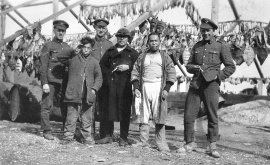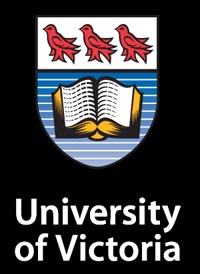The Asian Communities of Vladivostok
This special exhibit is now under development, a collaborative effort between Dr. Benjamin Isitt, director of the Siberian Expedition Virtual Exhibition, Dr. Blaine Chiasson of Wilfrid Laurier University, and PhD candidate Joel Legassie of the University of Victoria. When complete, it will provide a compelling look at Canadian perceptions of Vladivostok's Asian inhabitants, who totalled one-third of the city's population during the Allied occupation.

Sidney Rodger Collection, Beamsville, Ontario
Canadian soldiers and ethnically Chinese fishers at Gornostai Bay, 1919. The Canadians seemed to interact more with Vladivostok's ethnically Chinese and Korean population (which totalled one-third of local inhabitants at the time) than with European Russians, who were suspected of Bolshevik sympathies.
View more photos like this in the archive
"We were struck by the curious inhabitants who were about the wharf. Chiefly Manchurians well built & strong looking Mongolians and not like the Coolies so frequently seen in B.C. They were employed in unloading the boat & native transport being largely used."
"The means of transport appears to be largely done on the backs of Manchurians."
"It was very interesting going through the place and one was struck by the cosmopolitan aspect of the population. In 15 minutes march I recognized 18 different nationalities. They seemed to represent the worst type of the nation to which they belonged in most cases. Besides the civilians there were the troops of the all the Allied Forces in Siberia mingled. British (Imperials & Canadians, the Hamsphires & Middlesex regiments). American troops who had been there since Aug/18, French, Italian, Japanese (efficient surly looking soldiers), Czecho-Slovaks, of course numerous Russians in all manner of uniforms."
— excerpts from the diary of Capt. Eric Elkington, Vladivostok, 1918-191
Back to Life in Vladivostok
Notes
- 1Capt. Erik Henry William Elkington diary, n.d. (c. January 1919), E.H.W. Elkington Family Collection (private collection), Ladysmith, BC.
Go to
Les communautés asiatiques de Vladivostok
Cette exposition spéciale est maintenant en cours de développement, un effort de collaboration entre Dr. Benjamin Isitt, directeur de l’Exposition Virtuelle de l’expédition canadienne en Sibérie, Dr. Blaine Chiasson de l'Université Wilfrid Laurier, et candidat au doctorat Joel Legassie de l'Université de Victoria. Une fois terminé, il fournira un regard fascinant des perceptions canadiennes des habitants asiatiques de Vladivostok, qui composa un tiers de la population de la ville pendant l'occupation Alliée.

Collection Sidney Rodger, Beamsville, Ontario
Soldats canadiens et pêcheurs chinois à Gornostai Bay, 1919. Les Canadiens semblaient interagir avec la population ethniquement chinoise et coréenne de Vladivostok (qui totalisèrent un tiers des habitants de la région à l'époque) plus qu’avec les Russes européens, qui étaient soupçonnés de sympathies Bolchéviks.
Voir d'autres photos semblables dans l'archive
« Les habitants curieux qui étaient sur le quai nous captivèrent. Principalement Mandchous, Mongols forts et en santés contrairement aux « coolies » si souvent vu en Colombie-Britannique. Ils étaient employés au déchargement des bateaux et le transport natif était largement utilisé ».
« Les moyens de transport semblent être en grande partie fait sur le dos des Mandchous ».
« Passer par cette place fut très intéressant et nous étions frappé par l'aspect cosmopolite de la population. En 15 minutes, j’ai reconnu 18 nationalités. Ils semblaient représenter le pire type de la nation à laquelle ils appartiennent. En plus des civils, il y avait les diverses troupes Alliées, incluant les Britanniques (Impériaux et Canadiens, les régiments d’Hamsphire & Middlesex), Américains qui étaient là depuis le 18 aout, Français, Italiens, Japonais (qui étaient efficacement hargneux), Tchécoslovaques, et bien sûr de nombreux Russes dans toutes sortes d'uniformes ».
— Extrait du diary du capitaine Eric Elkington, Vladivostok, 1918-19191
Retour à La vie à Vladivostok
Notes
- 1 Journal du captaine Eric Henry William Elkington, n.d. (c. January 1919), Collection de la famille E.H.W. Elkington, Ladysmith, C.B.
Sauter à
Азиатские общины Владивостока
Специальная виртуальная выставка, посвященная азиатским общинам Владивостока находится в разработке, над проектом работают Бенджамин Айситт &endash; директор Виртуальной выставки о Канадской сибирской экспедиции, Блэйн Циэссон из Университета Вилфреда Лауриера и Джоел Легасси из Уиниверситета Виктории. Когда работа завершится, можно будет рассуждать о канадском восприятии многочисленных азиатских общин Владивостока, которые составляли треть от всего населения города во время союзнической интервенции.

Коллекция Сидней Роджера, Бимсвилль, Канада
Канадские солдаты и этнические китайские рыбаки в бухте Горностай, 1919г. Канадцы больше взаимодействовали и контактировали с этническими китайцами и корейцами во Владивостоке, чем с местным русским населением, которое подозревали в симпатии к большевикам.
Смотрите больше фотографий в архиве
«Мы были поражены разнообразием поселенцев и рабочих на верфях. Деловитые маньчжуры, чтоб были отменными строителями, крепкие монголы. Они нанимались для разгрузки рыбных лодок и кораблей на верфях».
«Это было очень интересно гулять по городским местам и приходить в восторг от того, насколько космополитично население Владивостока. В пятнадцати минутной прогулке по городу я различил 18 разных национальностей. И все они выглядели не очень хорошими представителями своих наций, к которым они имели отношения. За исключение гражданских во всей Сибири были войска всех союзнических сил. Британцы (Императорские силы, канадцы, и другие военные контингенты). Американские войска, что были здесь с 18 августа, а также французы, итальянцы, японцы (хорошо подготовленные сердитые солдаты), чехословаки и, конечно же, многочисленные русские войска в разнообразном обмундировании».
— выдержки из дневника капитана Эрика Элкингтона. Владивосток, 1918-1919гг.1
Назад Жизнь во Владивостоке
Примечания
- 1Diary of Eric Elkington, n.d. (c. January 1919), p. 2, E.H.W. Elkington Family Collection (private collection), Ladysmith, BC.
Перейти к
Research Question
How did the Canadians view, and interact with, Vladivostok's ethnically Chinese and Korean inhabitants?
Key Themes
- • ethnic diversity of Vladivostok
- • "colonial gaze" of the Canadian troops
- • photographic representation of the "other"
Question de recherche
Comment est-ce que les Canadiens virent et interagirent avec les habitants ethniquement chinois et coréen de Vladivostok?
Principaux thèmes
- • la diversité ethnique de Vladivostok
- • point de vue « colonial » des troupes canadiennes
- • la représentation photographique de « l'autre »
Исследовательский вопрос
Как канадцы воспринимали и относились к выходцам из Китая и Кореи во Владивостоке?
Ключевые темы
- • Этническое разнообразие во Владивостоке
- • «колониальный взгляд» в рядах канадских войск
- • фотографическое представление «иных»
Primary Documents
Multi-Media
Secondary Sources
Ernest Zitser, "'A Dirty Place for Americans to Be': Images of the Russian Civil War in Siberia from the Robert L. Eichelberger Collection at Duke University Libraries," Slavic and Eastern European Information Resources, 10, no. 1 (2009), 29-44.
Explores photographic representations of the civilian population and the "colonial gaze" of the foreign troops.Lewis H. Siegelbaum, “Another Yellow Peril: Chinese Migrants in the Russian Far East and the Russian Reaction before 1917," Modern Asian Studies 12, no. 2 (1978), 307-330
Documents primaire
Multimédia
- Entretien avec Eric Elkington
- Documentaire radio de la CBC « Canada and the Siberian intervention » (1970)
Sources secondaires
Ernest Zitser, "'A Dirty Place for Americans to Be': Images of the Russian Civil War in Siberia from the Robert L. Eichelberger Collection at Duke University Libraries," Slavic and Eastern European Information Resources, 10, no. 1 (2009), 29-44.
Explorez les représentations photographiques de la population civile et le point de vue « colonial » des troupes étrangères.Lewis H. Siegelbaum, “Another Yellow Peril: Chinese Migrants in the Russian Far East and the Russian Reaction before 1917," Modern Asian Studies 12, no. 2 (1978), 307-330
Первичные документы
Мультимедиа
Вторичные источники
Ernest Zitser, "'A Dirty Place for Americans to Be': Images of the Russian Civil War in Siberia from the Robert L. Eichelberger Collection at Duke University Libraries," Slavic and Eastern European Information Resources, 10, no. 1 (2009), 29-44.
Переданный на фотографиях «Колониальный взгляд» иностранных войск на гражданское население Владивостока.Lewis H. Siegelbaum, “Another Yellow Peril: Chinese Migrants in the Russian Far East and the Russian Reaction before 1917," Modern Asian Studies 12, no. 2 (1978), 307-330
 English
English Français
Français Русский
Русский

